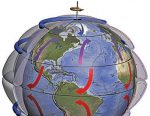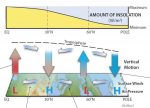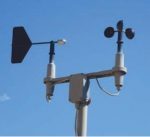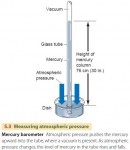
How Have Global Pressures and Winds Affected History in the North Atlantic?
INTERCONTINENTAL TRAVEL AND TRADE have relied upon moving currents in the air and oceans. Before the 20th century, when transoceanic travel and shipping relied on wind power, global winds, such as the trade winds and westerlies, dictated which directions of travel were possible at different latitudes. The directions of global winds therefore greatly influenced the […]

How Do Variations in Insolation Cause Global Patterns of Air Pressure and Circulation?
SEASONAL AND LATITUDINAL VARIATIONS IN INSOLATION cause regional differences in air pressure, which in turn set up regional and global systems of air circulation. These circulation patterns account for many of the characteristics of a region's climate (hot, cold, wet, dry), prevailing wind directions, and typical weather during different times of the year. Here, we […]

How Do Variations in Temperature and Pressure Cause Local Atmospheric Circulation?
PRESSURE GRADIENTS INDUCE FLOW at all scales, including local and regional ones, arising from unequal heating by insolation and latent heat, by differing thermal responses of land versus sea, and even from the construction of large metropolitan areas. Such circulations contribute to the climate of a place, particularly in the absence of, or interaction with, […]

What Causes Pressure Variations and Winds?
THE MOVEMENT OF AIR IN THE ATMOSPHERE produces wind, or movement of air relative to Earth's surface. Circulation in the atmosphere is caused by pressure differences generated primarily by uneven insolation. Air flows from areas of higher pressure, where air sinks, to areas of lower pressure, where air rises. How Do We Measure the Strength […]

What Is Air Pressure?
PRESSURE OF GASES WITHIN THE ATMOSPHERE is highly variable, both vertically and laterally. These variations in pressure define the structure of the atmosphere and also determine the nature and direction of atmospheric motions. If one place in the atmosphere has higher pressure than another place, this imbalance of pressure (and therefore also atmospheric mass) must […]

How Do Gases Respond to Changes in Temperature and Pressure?
THE ATMOSPHERE CONSISTS LARGELY OF GASES, with lesser amounts of liquids, such as drops of water, and solids, such as dust and ice. By nature, gases expand easily or contract in volume in response to changes in temperature and pressure. Variations in temperature and resulting changes in pressure are the main drivers of motion in […]

Global Wind and Pressure Patterns
For simplicity, let's begin by looking at surface winds and pressure patterns on an ideal Earth that does not have oceans and continents, or seasons (Figure 5.16). Hadley cells are key to an understanding of the wind patterns on our ideal Earth. These form because the Equator is heated more strongly by the Sun than other places, creating thermal circulations. Air […]

Atmospheric Pressure
We live at the bottom of a vast ocean of air—the Earth's atmosphere. Like the water in the ocean, the air in the atmosphere is constantly pressing on the Earth's surface beneath it and on everything that it surrounds. The atmosphere exerts pressure because gravity pulls the gas molecules of the air toward the Earth. Gravity is an attraction among all […]